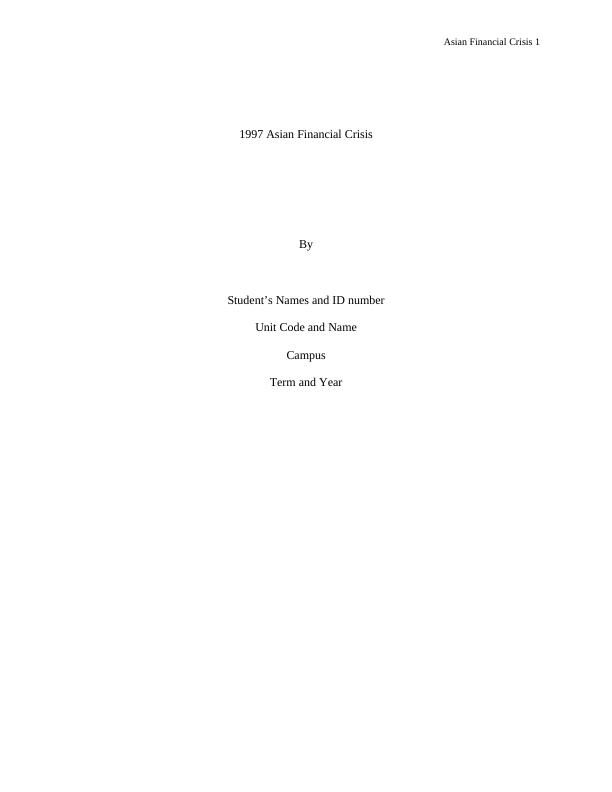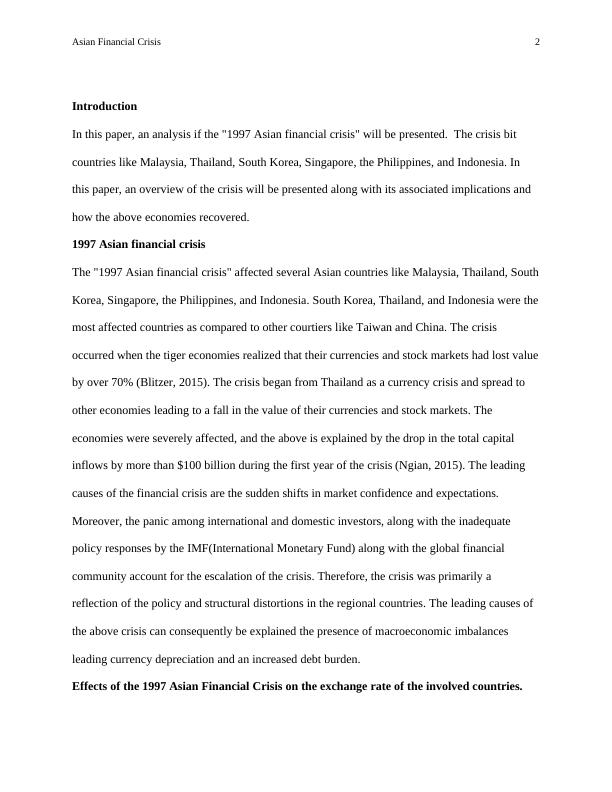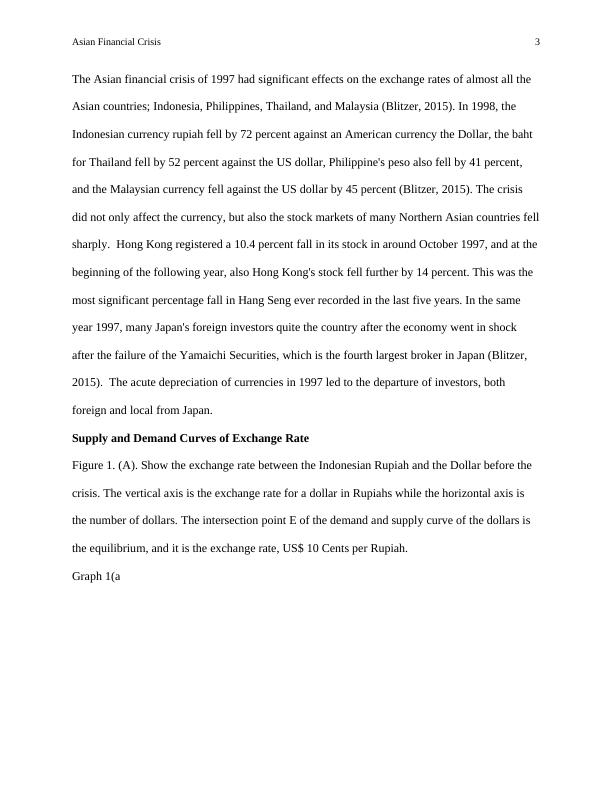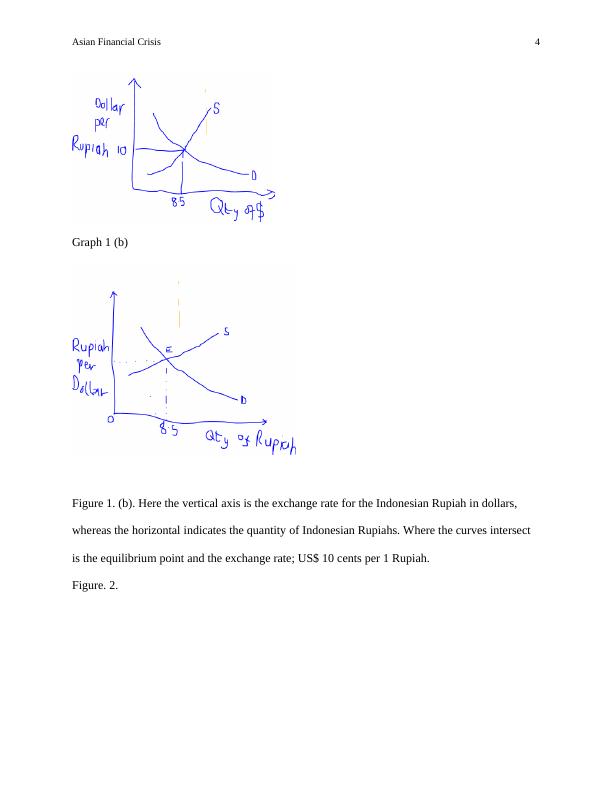1997 Asian Financial Crisis: Causes, Effects, and Recovery
Added on 2023-04-04
11 Pages2239 Words146 Views
Asian Financial Crisis 1
1997 Asian Financial Crisis
By
Student’s Names and ID number
Unit Code and Name
Campus
Term and Year
1997 Asian Financial Crisis
By
Student’s Names and ID number
Unit Code and Name
Campus
Term and Year

Asian Financial Crisis 2
Introduction
In this paper, an analysis if the "1997 Asian financial crisis" will be presented. The crisis bit
countries like Malaysia, Thailand, South Korea, Singapore, the Philippines, and Indonesia. In
this paper, an overview of the crisis will be presented along with its associated implications and
how the above economies recovered.
1997 Asian financial crisis
The "1997 Asian financial crisis" affected several Asian countries like Malaysia, Thailand, South
Korea, Singapore, the Philippines, and Indonesia. South Korea, Thailand, and Indonesia were the
most affected countries as compared to other courtiers like Taiwan and China. The crisis
occurred when the tiger economies realized that their currencies and stock markets had lost value
by over 70% (Blitzer, 2015). The crisis began from Thailand as a currency crisis and spread to
other economies leading to a fall in the value of their currencies and stock markets. The
economies were severely affected, and the above is explained by the drop in the total capital
inflows by more than $100 billion during the first year of the crisis (Ngian, 2015). The leading
causes of the financial crisis are the sudden shifts in market confidence and expectations.
Moreover, the panic among international and domestic investors, along with the inadequate
policy responses by the IMF(International Monetary Fund) along with the global financial
community account for the escalation of the crisis. Therefore, the crisis was primarily a
reflection of the policy and structural distortions in the regional countries. The leading causes of
the above crisis can consequently be explained the presence of macroeconomic imbalances
leading currency depreciation and an increased debt burden.
Effects of the 1997 Asian Financial Crisis on the exchange rate of the involved countries.
Introduction
In this paper, an analysis if the "1997 Asian financial crisis" will be presented. The crisis bit
countries like Malaysia, Thailand, South Korea, Singapore, the Philippines, and Indonesia. In
this paper, an overview of the crisis will be presented along with its associated implications and
how the above economies recovered.
1997 Asian financial crisis
The "1997 Asian financial crisis" affected several Asian countries like Malaysia, Thailand, South
Korea, Singapore, the Philippines, and Indonesia. South Korea, Thailand, and Indonesia were the
most affected countries as compared to other courtiers like Taiwan and China. The crisis
occurred when the tiger economies realized that their currencies and stock markets had lost value
by over 70% (Blitzer, 2015). The crisis began from Thailand as a currency crisis and spread to
other economies leading to a fall in the value of their currencies and stock markets. The
economies were severely affected, and the above is explained by the drop in the total capital
inflows by more than $100 billion during the first year of the crisis (Ngian, 2015). The leading
causes of the financial crisis are the sudden shifts in market confidence and expectations.
Moreover, the panic among international and domestic investors, along with the inadequate
policy responses by the IMF(International Monetary Fund) along with the global financial
community account for the escalation of the crisis. Therefore, the crisis was primarily a
reflection of the policy and structural distortions in the regional countries. The leading causes of
the above crisis can consequently be explained the presence of macroeconomic imbalances
leading currency depreciation and an increased debt burden.
Effects of the 1997 Asian Financial Crisis on the exchange rate of the involved countries.

Asian Financial Crisis 3
The Asian financial crisis of 1997 had significant effects on the exchange rates of almost all the
Asian countries; Indonesia, Philippines, Thailand, and Malaysia (Blitzer, 2015). In 1998, the
Indonesian currency rupiah fell by 72 percent against an American currency the Dollar, the baht
for Thailand fell by 52 percent against the US dollar, Philippine's peso also fell by 41 percent,
and the Malaysian currency fell against the US dollar by 45 percent (Blitzer, 2015). The crisis
did not only affect the currency, but also the stock markets of many Northern Asian countries fell
sharply. Hong Kong registered a 10.4 percent fall in its stock in around October 1997, and at the
beginning of the following year, also Hong Kong's stock fell further by 14 percent. This was the
most significant percentage fall in Hang Seng ever recorded in the last five years. In the same
year 1997, many Japan's foreign investors quite the country after the economy went in shock
after the failure of the Yamaichi Securities, which is the fourth largest broker in Japan (Blitzer,
2015). The acute depreciation of currencies in 1997 led to the departure of investors, both
foreign and local from Japan.
Supply and Demand Curves of Exchange Rate
Figure 1. (A). Show the exchange rate between the Indonesian Rupiah and the Dollar before the
crisis. The vertical axis is the exchange rate for a dollar in Rupiahs while the horizontal axis is
the number of dollars. The intersection point E of the demand and supply curve of the dollars is
the equilibrium, and it is the exchange rate, US$ 10 Cents per Rupiah.
Graph 1(a
The Asian financial crisis of 1997 had significant effects on the exchange rates of almost all the
Asian countries; Indonesia, Philippines, Thailand, and Malaysia (Blitzer, 2015). In 1998, the
Indonesian currency rupiah fell by 72 percent against an American currency the Dollar, the baht
for Thailand fell by 52 percent against the US dollar, Philippine's peso also fell by 41 percent,
and the Malaysian currency fell against the US dollar by 45 percent (Blitzer, 2015). The crisis
did not only affect the currency, but also the stock markets of many Northern Asian countries fell
sharply. Hong Kong registered a 10.4 percent fall in its stock in around October 1997, and at the
beginning of the following year, also Hong Kong's stock fell further by 14 percent. This was the
most significant percentage fall in Hang Seng ever recorded in the last five years. In the same
year 1997, many Japan's foreign investors quite the country after the economy went in shock
after the failure of the Yamaichi Securities, which is the fourth largest broker in Japan (Blitzer,
2015). The acute depreciation of currencies in 1997 led to the departure of investors, both
foreign and local from Japan.
Supply and Demand Curves of Exchange Rate
Figure 1. (A). Show the exchange rate between the Indonesian Rupiah and the Dollar before the
crisis. The vertical axis is the exchange rate for a dollar in Rupiahs while the horizontal axis is
the number of dollars. The intersection point E of the demand and supply curve of the dollars is
the equilibrium, and it is the exchange rate, US$ 10 Cents per Rupiah.
Graph 1(a

Asian Financial Crisis 4
Graph 1 (b)
Figure 1. (b). Here the vertical axis is the exchange rate for the Indonesian Rupiah in dollars,
whereas the horizontal indicates the quantity of Indonesian Rupiahs. Where the curves intersect
is the equilibrium point and the exchange rate; US$ 10 cents per 1 Rupiah.
Figure. 2.
Graph 1 (b)
Figure 1. (b). Here the vertical axis is the exchange rate for the Indonesian Rupiah in dollars,
whereas the horizontal indicates the quantity of Indonesian Rupiahs. Where the curves intersect
is the equilibrium point and the exchange rate; US$ 10 cents per 1 Rupiah.
Figure. 2.

End of preview
Want to access all the pages? Upload your documents or become a member.
Related Documents
1997 Asian Financial Crisislg...
|9
|2283
|251
The European Balance of Payments Crisis - PDFlg...
|4
|809
|32
(Solution) Financial Economics : PDFlg...
|6
|830
|28
International Financelg...
|12
|4090
|417
Asian and Mexican financial crises Case Study 2022lg...
|4
|357
|15
Essay: The Asian Crisis of 1997lg...
|10
|2608
|81
